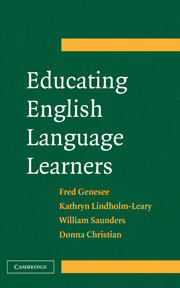6 - Conclusions and Future Directions
Published online by Cambridge University Press: 13 July 2009
Summary
In Chapters 2 through 5, we presented research findings and methodological issues specific to each domain of learning. In this chapter, we turn to common trends in the research findings reviewed in Chapters 2 through 5 and then go on to identify directions for future research.
COMMON TRENDS
Role of ELLs' First Language
The first notable trend is the influential role that ELLs' native language plays in their educational achievement. Maintenance and development of ELLs' L1 is influential in all domains we examined: oral language, literacy, and academic achievement. The influence of the L1 was evident in studies that examined planned instructional or programmatic interventions (Chapter 5) and those that examined unconscious, implicit processes that are implicated in literacy and oral language development (in Chapters 2 and 3; for example, when ELLs draw on their knowledge of cognates in the L1 when decoding words in the L2 or the transfer of reading comprehension strategies from the L1 to the L2). In citing evidence in support of maintaining and using ELLs' L1, we do not deny the critical importance of English for educational achievement. We noted in Chapters 2 and 4 that there is an important link between L2 exposure and proficiency and the development of literacy skills in English. However, the importance of ELLs' L1 raises an educational challenge.
- Type
- Chapter
- Information
- Educating English Language LearnersA Synthesis of Research Evidence, pp. 223 - 234Publisher: Cambridge University PressPrint publication year: 2006
- 8
- Cited by



